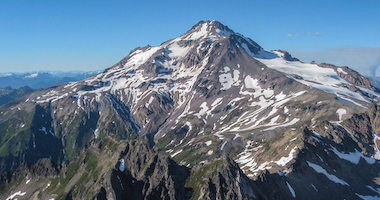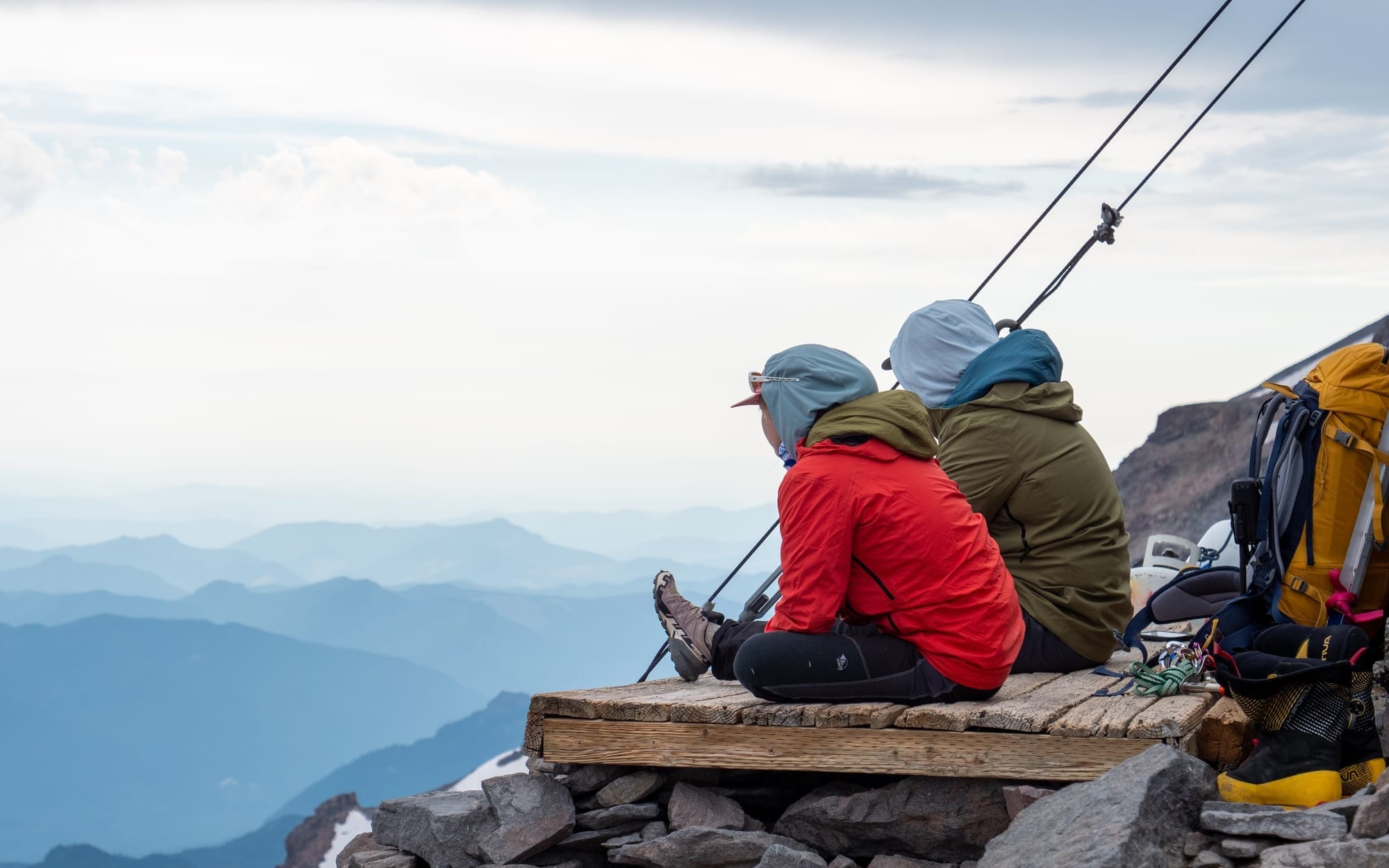Mount Rainier expeditions typically split into two styles: those that use Camp Muir (the established high camp at 10,080 feet) and those that set up their own camps in the wilderness. But whichever route you choose, there’s a daily rhythm to life on the mountain—alpine starts included. Below is an inside look at how a day unfolds on Rainier, plus extra details on Camp Muir’s unique history and facilities.
The History of Camp Muir
Camp Muir traces its roots back to 1888, when naturalist John Muir summited Mount Rainier and later inspired generations of climbers to follow in his footsteps. Originally known as “Cloud Camp,” the site was eventually renamed “Camp Muir” in his honor. Over the decades, the National Park Service and volunteer groups improved the camp, adding stone shelters and other structures to support both guided and independent expeditions.
What’s at Camp Muir Today?
At 10,080 feet on Rainier’s south side, Camp Muir is a major waypoint for climbers attempting the Disappointment Cleaver or Ingraham Direct routes. Here’s what you’ll find:
- Public Climber’s Shelter
A stone shelter that can offer some respite from the elements. Space is often tight, so come prepared with a tent or plan to sleep in the bunks only if room is available. - RMI Private Bunkhouse
On guided climbs, RMI teams access a dedicated building with bunk-style accommodations. This provides a bit more comfort and organization than the public shelter. - Vault Toilets
A major convenience at 10,000+ feet! These help minimize environmental impact and keep the area cleaner than a standard “blue-bag-only” situation. - Dedicated Kitchen Areas
Guides often use established snow-melting stations and designated cooking spaces to keep things efficient and safe.
Life at Camp Muir: A Structured Experience
When you stay at Camp Muir, your night at high altitude is relatively organized. It’s still “camping,” but with some amenities you won’t find in a remote glacier setting.
- Shared Spaces & Community
Expect to see other teams—both guided and independent—using the same facilities. Camp Muir is a social hub, allowing you to swap stories and route intel. - Shorter Summit Push
Starting at 10,080 feet means the summit is often 4,300 vertical feet away. That’s less distance than from a lower-elevation wilderness camp, making for a more direct climb on summit day. - Guided vs. Independent
- RMI Clients: Use the private bunkhouse, which can be a game-changer when storms roll in or temperatures drop.
- Independent Climbers: May need to bring tents if the public shelter is full. Plan for a “first-come, first-served” scenario in tight quarters.
Alpine Camping: Crafting Your Own High Camp
On routes like Emmons-Winthrop, Kautz Glacier, and Liberty Ridge, teams establish their own camps. These are typically perched on snow platforms carved into the glacier, offering a more remote and self-sufficient experience.
- Tent Platforms
You’ll shovel and pack snow to create a flat spot for your tent, sometimes adding walls for wind protection. - Snow Kitchens
A carefully dug cooking alcove in the snow helps shield stoves from gusts and spin-drift. - Toileting
With no vault toilets, blue-bagging (packing out your solid waste) is mandatory. This keeps the environment pristine for future climbers. - Lower Foot Traffic
Wilderness camps are quieter and often more scenic, but also require more work. No permanent structures, no bunkhouses—just you, your gear, and the mountain.
A Typical Day on Mount Rainier (Wherever You Camp)
Climbing Rainier generally follows a 2–3 day itinerary, though it can be longer for certain routes. Here’s the broad stroke of how most days look:
- Morning Routine
- Wake up early (but not “alpine-start early” yet).
- Boil water for breakfast and hydration.
- Break down or tidy up camp, organize gear, and review the day’s plan.
- Midday Movement & Skills
- Depending on your program, you’ll either hike up to high camp (Camp Muir or a wilderness campsite) or spend the day practicing skills like self-arrest, rope-team travel, and crevasse rescue if you’re already established at high camp.
- Evening Prep
- Final gear check for the summit push.
- Lay out your crampons, harness, helmet, headlamp, snacks—everything you’ll need in the dark.
- Turn in early, because your alarm is about to go off shockingly soon.
The Alpine Start: Why So Early?
An “alpine start” typically means setting out for the summit anywhere between 11 PM and 2 AM. Sounds extreme, right? But there’s method to this early-morning madness:
- Firmer Snow
Overnight temps freeze the upper snowpack, making travel safer over crevasses and lessening rockfall risk on routes like Disappointment Cleaver. - More Stable Weather
Unstable weather is likelier in the afternoon, so summiting early and descending before mid-day storms is ideal. - Time Buffer
If anything goes wrong—like a route-finding error or slowed pace—an early start leaves wiggle room to address problems in daylight.
Summit Day: Camp Muir vs. Wilderness Camps
Despite the common alpine start, the summit push differs slightly between Camp Muir-based climbs and those from wilderness camps.
- Camp Muir Summit Push
- Departure Time: Often between 11 PM and 2 AM.
- Route: Typically Ingraham Direct or Disappointment Cleaver.
- Descent: After summiting, climbers return directly to Camp Muir to rest before descending further.
- Wilderness Camp Summit Push
- Longer Approaches: You might start even earlier to cover more ground.
- Route Variety: Emmons-Winthrop, Kautz Ice Chutes, Liberty Ridge—all have unique hazards and scenic rewards.
- Return Strategy: Some teams come back to the same high camp; others descend a different route.
Choosing Your Rainier Experience
Both Camp Muir-based and wilderness expeditions allow you to spend time in one of the most iconic alpine environments in the U.S. Your choice boils down to how independent or “plug-and-play” you want your camp life to be—and how comfortable you are with the extra logistics of building your own home on the ice.
| Program Type | Best For | Primary Challenges |
|---|---|---|
| Camp Muir Programs | Those seeking a more structured camp environment | Higher foot traffic and limited bunk space |
| Wilderness Camping | Climbers wanting more solitude and self-reliance | Camp setup, weather exposure, and heavier packs |
The RMI Advantage: Expertise No Matter the Route
With decades of experience on Rainier, RMI Expeditions offers guided climbs for both Camp Muir-based and wilderness expeditions:
- Camp Muir Programs: Enjoy a private bunkhouse, shorter route, and step-by-step guidance from our expert team.
- Other Routes: Experience the thrill of a remote climb with the safety net of seasoned guides who excel at route-finding, camp setup, and high-altitude leadership.
Ready to Plan Your Day on Mount Rainier?
From the moment you unzip your tent flap in the wee hours to those triumphant summit photos, Rainier demands preparation and respect. Whether you stay at Camp Muir or dig your own snow platform, the rewards—and the alpine starts—are well worth it.
Explore RMI’s Guided Climbing Programs to find the perfect Rainier adventure for your style, timeline, and goals. We handle the logistics so you can savor every moment of the climb—alpine start and all!
















